What Heritage Bilinguals Tell Us about the Language of Emotion
Abstract
:1. Introduction
1.1. Emotion and Bilingualism
1.2. Emotion, Bilingualism, and Memory
1.3. Emotion-Memory Paradigm
1.4. Emotion Processing in Heritage Bilinguals
2. Methods
2.1. Participants
2.2. Experimental Design
2.2.1. Emotional Rating Task
2.2.2. Recognition Test
2.3. Measuring Language Dominance and Language Proficiency in Bilinguals
2.3.1. Bilingual Language Profile Questionnaire
2.3.2. Verbal Fluency Task
2.3.3. Elicited Imitation Task
2.4. Experiment Procedure
2.5. Data Trimming
2.6. Data Analysis
3. Results
3.1. Emotional Rating
3.2. Recognition of Emotional Words versus Neutral Words
3.3. Recognition of Preceding and Following Neutral Words
3.4. The Role of Language Dominance and Proficiency
4. Discussion
5. Limitations and Conclusions
Author Contributions
Funding
Institutional Review Board Statement
Informed Consent Statement
Data Availability Statement
Conflicts of Interest
Appendix A
| Negative Words | Taboo Words | Neutral Words |
|---|---|---|
| 1. abuse | 1. anus | 1. apron |
| 2. anger | 2. asshole | 2. belt |
| 3. cancer | 3. bitch | 3. cap |
| 4. crash | 4. breast | 4. coat |
| 5. cruel | 5. cock | 5. dress |
| 6. death | 6. dick | 6. fur |
| 7. doom | 7. dildo | 7. jacket |
| 8. fail | 8. dyke | 8. nylons |
| 9. grief | 9. fuck | 9. parka |
| 10. guilt | 10. nigger | 10. purse |
| 11. hate | 11. piss | 11. robe |
| 12. kill | 12. pussy | 12. shirt |
| 13. misery | 13. queer | 13. shoes |
| 14. pain | 14. rape | 14. shorts |
| 15. panic | 15. shit | 15. skirts |
| 16. rage | 16. slut | 16. slip |
| 17. shock | 17. vagina | 17. socks |
| 18. sorrow | 18. whore | 18. watch |
| 1. | For example, Wong and Ng (2018) tested the moral behavior of early English–Mandarin bilinguals in Singapore in both their languages and found that “the more dominant participants were in their tested language, the larger the difference between their personal and impersonal dilemma response choice”. Therefore, language dominance as measured by the Bilingual Language Profile was significantly correlated to a higher emotional response. Although a different paradigm, this contrasts the findings of Ferré et al. (2010). Research is needed to see whether the Bilingual Language Profile provides a more nuanced and careful measure of language dominance in relation to emotion–memory effects in bilinguals. |
References
- Altarriba, Jeannette. 2014. Emotion, memory, and bilingualism. In Foundations of Bilingual Memory. New York: Springer, pp. 185–203. [Google Scholar]
- Amengual, Mark. 2016. Acoustic correlates of the Spanish tap-trill contrast: Heritage and L2 Spanish speakers. Heritage Language Journal 13: 88–112. [Google Scholar] [CrossRef]
- American Academy of Arts and Sciences. 2017. America’s Languages: Investing in Language Education for the 21st Century. Cambridge: American Academy of Arts and Sciences. [Google Scholar]
- Anderson, Adam K., Peter E. Wais, and John D. E. Gabrieli. 2006. Emotion enhances remembrance of neutral events past. Proceedings of the National Academy of Sciences of the United States of America 103: 1599–604. [Google Scholar] [CrossRef] [PubMed] [Green Version]
- Anooshian, Linda J., and Paula T. Hertel. 1994. Emotionality in free recall: Language specificity in bilingual memory. Cognition and Emotion 8: 503–14. [Google Scholar] [CrossRef]
- Ayçiçegi, Ayşe, and Catherine Harris. 2004. BRIEF REPORT Bilinguals’ recall and recognition of emotion words. Cognition and Emotion 18: 977–87. [Google Scholar] [CrossRef]
- Ayçiçegi-Dinn, Ayse, and Catherine L. Caldwell-Harris. 2009. Emotion-memory effects in bilingual speakers: A levels-of-processing approach. Bilingualism: Language and Cognition 12: 291–303. [Google Scholar] [CrossRef] [Green Version]
- Balota, David A., Melvin J. Yap, Keith A. Hutchison, Michael J. Cortese, Brett Kessler, Bjorn Loftis, James H. Neely, Douglas L. Nelson, Greg B. Simpson, and Rebecca Treiman. 2007. The English lexicon project. Behavior Research Methods 39: 445–59. [Google Scholar] [CrossRef] [Green Version]
- Bates, Douglas, Martin Mächler, Ben Bolker, and Steve Walker. 2015. Fitting linear mixed-effects models using lme4. Journal of Statistical Software 67: 1–48. [Google Scholar] [CrossRef]
- Bauer, Lisa M., and Jeanette Altarriba. 2008. An investigation of sex differences in word ratings across concrete, abstract, and emotion words. The Psychological Record 58: 465–74. [Google Scholar] [CrossRef] [Green Version]
- Beatty-Martínez, Anne L., Christian A. Navarro-Torres, Paola E. Dussias, María Teresa Bajo, Rosa E. Guzzardo Tamargo, and Judith F. Kroll. 2020. Interactional context mediates the consequences of bilingualism for language and cognition. Journal of Experimental Psychology: Learning, Memory, and Cognition 46: 1022–47. [Google Scholar] [CrossRef]
- Beatty-Martínez, Anne L., and Debra A. Titone. 2021. The quest for signals in noise: Leveraging experiential variation to identify bilingual phenotypes. Languages 6: 168. [Google Scholar] [CrossRef]
- Birdsong, David. 2014. Dominance and age in bilingualism. Applied Linguistics 35: 374–92. [Google Scholar] [CrossRef] [Green Version]
- Birdsong, David, Libby M. Gertken, and Mark Amengual. 2012. Bilingual Language Profile: An Easy-to-Use Instrument to Assess Bilingualism. Austin: COERLL, University of Texas at Austin. [Google Scholar]
- Bowden, Harriet Wood. 2016. Assessing second-language oral proficiency for research: The Spanish elicited imitation task. Studies in Second Language Acquisition 38: 647–75. [Google Scholar] [CrossRef]
- Brown, Violet A. 2021. An Introduction to Linear Mixed-Effects Modeling in R. Advances in Methods and Practices in Psychological Science 4: 1–19. [Google Scholar] [CrossRef]
- Caldwell-Harris, Catherine L. 2015. Emotionality differences between a native and foreign language: Implications for everyday life. Current Directions in Psychological Science 24: 214–19. [Google Scholar] [CrossRef]
- Caldwell-Harris, Catherine L., and Ayşe Ayçiçeği-Dinn. 2009. Emotion and lying in a non-native language. International Journal of Psychophysiology 71: 193–204. [Google Scholar] [CrossRef] [PubMed]
- Caldwell-Harris, Catherine L., Jimmy Tong, Winvy Lung, and Sinlan Poo. 2011. Physiological reactivity to emotional phrases in Mandarin—English bilinguals. International Journal of Bilingualism 15: 329–52. [Google Scholar] [CrossRef] [Green Version]
- Cipolletti, Heather, Steven McFarlane, and Christine Weissglass. 2016. The moral foreign-language effect. Philosophical Psychology 29: 23–40. [Google Scholar] [CrossRef]
- Costa, Albert, Alice Foucart, Inbal Arnon, Melina Aparici, and Jose Apesteguia. 2014. “Piensa” twice: On the foreign language effect in decision making. Cognition 130: 236–54. [Google Scholar] [CrossRef]
- Dewaele, Jean-Marc. 2004. The emotional force of swearwords and taboo words in the speech of multilinguals. Journal of Multilingual and Multicultural Development 25: 204–2. [Google Scholar] [CrossRef]
- Dewaele, Jean-Marc, and Seiji Nakano. 2013. Multilinguals’ perceptions of feeling different when switching languages. Journal of Multilingual and Multicultural Development 34: 107–20. [Google Scholar] [CrossRef] [Green Version]
- Dewaele, Jean-Marc, and Aneta Pavlenko. 2002. Emotion vocabulary in interlanguage. Language Learning 52: 263–322. [Google Scholar] [CrossRef]
- Dunsmoor, Joseph E., Marijn C. W. Kroes, Vishnu P. Murty, Stephen H. Braren, and Elizabeth A. Phelps. 2019. Emotional enhancement of memory for neutral information: The complex interplay between arousal, attention, and anticipation. Biological Psychology 145: 134–41. [Google Scholar] [CrossRef] [PubMed]
- Eilola, Tiina M., and Jelena Havelka. 2010. Behavioural and physiological responses to the emotional and taboo Stroop tasks in native and non-native speakers of English. International Journal of Bilingualism 15: 353–69. [Google Scholar] [CrossRef]
- Fan, Lin, Qiang Xu, Xiaoxi Wang, Fei Xu, Yaping Yang, and Zhi Lu. 2018. The automatic activation of emotion words measured using the emotional face-word Stroop task in late Chinese–English bilinguals. Cognition and Emotion 32: 315–24. [Google Scholar] [CrossRef]
- Ferré, Pilar, Teófilo García, Isabel Fraga, Rosa Sánchez-Casas, and Margarita Molero. 2010. Memory for emotional words in bilinguals: Do words have the same emotional intensity in the first and in the second language? Cognition and Emotion 24: 760–85. [Google Scholar] [CrossRef]
- FindingFive Team. 2019. FindingFive: A Web Platform for Creating, Running, and Managing Your Studies in One Place. Cherry Hill: FindingFive Corporation (Nonprofit), Available online: https://www.findingfive.com (accessed on 19 May 2022).
- Francis, Wendy S., and Marisela Gutiérrez. 2012. Bilingual recognition memory: Stronger performance but weaker levels-of-processing effects in the less fluent language. Memory and Cognition 40: 496–503. [Google Scholar] [CrossRef] [Green Version]
- Glanzer, Murray, and John K. Adams. 1985. The mirror effect in recognition memory. Memory & Cognition 13: 8–20. [Google Scholar]
- Grabovac, Beáta, and Csaba Pléh. 2014. Emotional activation measured using the emotional Stroop task in early Hungarian-Serbian bilinguals from Serbia. Acta Linguistica Hungarica 61: 423–41. [Google Scholar] [CrossRef] [Green Version]
- Green, David W., and Jubin Abutalebi. 2013. Language control in bilinguals: The adaptive control hypothesis. Journal of Cognitive Psychology 25: 515–30. [Google Scholar] [CrossRef]
- Guillet, Rebecca, and Jason Arndt. 2009. Taboo words: The effect of emotion on memory for peripheral information. Memory and Cognition 37: 866–79. [Google Scholar] [CrossRef] [Green Version]
- Gullifer, Jason W., and Debra Titone. 2020. Characterizing the social diversity of bilingualism using language entropy. Bilingualism: Language and Cognition 23: 283–94. [Google Scholar] [CrossRef] [Green Version]
- Hadley, Christopher B., and Donald G. MacKay. 2006. Does emotion help or hinder immediate memory? Arousal versus priority-binding mechanisms. Journal of Experimental Psychology: Learning, Memory, and Cognition 32: 79–88. [Google Scholar] [CrossRef] [PubMed]
- Hamann, Stephan. 2001. Cognitive and neural mechanisms of emotional memory. Trends in Cognitive Sciences 5: 394–400. [Google Scholar] [CrossRef]
- Harris, Catherine L. 2004. Bilingual speakers in the lab: Psychophysiological measures of emotional reactivity. Journal of Multilingual and Multicultural Development 25: 223–47. [Google Scholar] [CrossRef]
- Harris, Catherine L., Jean Berko Gleason, and Ayse Aycicegi. 2006. When is a first language more emotional? Psychophysiological evidence from bilingual speakers. Bilingual Education and Bilingualism 56: 257–83. [Google Scholar]
- Jankowiak, Katarzyna, and Paweł Korpal. 2018. On modality effects in bilingual emotional language processing: Evidence from galvanic skin response. Journal of Psycholinguistic Research 47: 663–77. [Google Scholar] [CrossRef] [Green Version]
- Kensinger, Elizabeth A., and Suzanne Corkin. 2003a. Effect of negative emotional content on working memory and long-term memory. Emotion 3: 378–93. [Google Scholar] [CrossRef] [Green Version]
- Kensinger, Elizabeth A., and Suzanne Corkin. 2003b. Memory enhancement for emotional words: Are emotional words more vividly remembered than neutral words? Memory and Cognition 31: 1169–80. [Google Scholar] [CrossRef] [Green Version]
- Keysar, Boaz, Sayuri L. Hayakawa, and Sun Gyu An. 2012. The foreign-language effect: Thinking in a foreign tongue reduces decision biases. Psychological Science 23: 661–68. [Google Scholar] [CrossRef]
- Kinginger, Celeste. 2004. Bilingualism and emotion in the autobiographical works of Nancy Huston. Journal of Multilingual and Multicultural Development 25: 159–78. [Google Scholar] [CrossRef]
- Knight, Marisa, and Mara Mather. 2009. Reconciling findings of emotion-induced memory enhancement and impairment of preceding items. Emotion 9: 763–81. [Google Scholar] [CrossRef] [PubMed] [Green Version]
- Kostromitina, Maria, and Luke Plonsky. 2021. Elicited imitation tasks as a measure of L2 proficiency: A meta-analysis. In Studies in Second Language Acquisition. Cambridge: Cambridge University Press, p. 1. [Google Scholar]
- Kroll, Judith F., Susan C. Bobb, Maya Misra, and Taomei Guo. 2008. Language selection in bilingual speech: Evidence for inhibitory processes. Acta Psychologica 128: 416–30. [Google Scholar] [CrossRef] [PubMed] [Green Version]
- Kroll, Judith F., Andrea Takahesu Tabori, and Christian Navarro-Torres. 2021. Capturing the variation in language experience to understand language processing and learning. Language, Interaction and Acquisition 12: 82–109. [Google Scholar] [CrossRef]
- Kučera, Henry, and W. Nelson Francis. 1967. Computational analysis of present-day American English. Journal of Experimental Psychology: General 143: 1065–81. [Google Scholar]
- Kuznetsova, Alexandra, Per B. Brockhoff, and Rune H. B. Christensen. 2017. lmerTest package: Tests in linear mixed effect models. Journal of Statistical Software 82: 1–26. [Google Scholar] [CrossRef] [Green Version]
- Kupisch, Tanja, and Jason Rothman. 2018. Terminology matters! Why difference is not incompleteness and how early child bilinguals are heritage speakers. International Journal of Bilingualism 22: 564–82. [Google Scholar] [CrossRef] [Green Version]
- Larsen, Steen Folke, Robert W. Schrauf, Pia Fromholt, and David C. Rubin. 2002. Inner speech and bilingual autobiographical memory: A Polish-Danish cross-cultural study. Memory 10: 45–54. [Google Scholar] [CrossRef]
- Levine, Linda J., and David A. Pizarro. 2004. Emotion and memory research: A grumpy overview. Social Cognition 22: 530–54. [Google Scholar] [CrossRef]
- Linck, Jared A., Judith F. Kroll, and Gretchen Sunderman. 2009. Losing access to the native language while immersed in a second language: Evidence for the role of inhibition in second-language learning. Psychological Science 20: 1507–15. [Google Scholar] [CrossRef] [Green Version]
- Luk, Gigi, and Ellen Bialystok. 2013. Bilingualism is not a categorical variable: Interaction between language proficiency and usage. Journal of Cognitive Psychology 25: 605–21. [Google Scholar] [CrossRef]
- Marian, Viorica, and Margarita Kaushanskaya. 2008. Words, feelings, and bilingualism: Cross-linguistic differences in emotionality of autobiographical memories. The Mental Lexicon 3: 72–91. [Google Scholar] [CrossRef] [PubMed] [Green Version]
- Okada, Kayoko, Grace He, and Alisa Gonzales. 2019. Monolinguals and bilinguals differ in performance on the Taboo Stroop task. The Open Psychology Journal 12: 135–40. [Google Scholar] [CrossRef]
- Ortega, Lourdes. 2000. Understanding Syntactic Complexity: The Measurement of Change in the Syntax of Instructed L2 Spanish Learners. Ph.D. dissertation, University of Hawai’i, Mānoa, Honolulu, HI, USA. [Google Scholar]
- Ortega, Lourdes, Noriko Iwashita, John Norris, and Sara Rabie. 2002. An investigation of elicited imitation in crosslinguistic SLA research. Paper Presented at the Meeting of the Second Language Research Forum, Toronto, ON, Canada, October 3–6. [Google Scholar]
- Pavlenko, Aneta. 2008. Emotion and emotion-laden words in the bilingual lexicon. Bilingualism: Language and Cognition 11: 147–64. [Google Scholar] [CrossRef] [Green Version]
- Pavlenko, Aneta. 2012. Affective processing in bilingual speakers: Disembodied cognition? International Journal of Psychology 47: 405–28. [Google Scholar] [CrossRef] [PubMed]
- Peña, Elizabeth D., Lisa M. Bedore, and Julio Torres. 2021. Assessment of language proficiency and dominance in monolinguals and bilinguals. In Bilingualism across the Lifespan. New York: Routledge, pp. 88–105. [Google Scholar]
- R Core Team. 2020. R: A Language and Environment for Statistical Computing. Vienna: R Foundation for Statistical Computing. [Google Scholar]
- Saraiva, Magda, Margarida V. Garrido, and Josefa N. S. Pandeirada. 2021. Surviving in a second language: Survival processing effect in memory of bilinguals. Cognition and Emotion 35: 417–24. [Google Scholar] [CrossRef] [PubMed]
- Schmidt, Stephen R., and Constance R. Schmidt. 2016. The emotional carryover effect in memory for words. Memory 24: 916–938. [Google Scholar] [CrossRef] [PubMed]
- Shao, Zeshu, Esther Janse, Karina Visser, and Antje S. Meyer. 2014. What do verbal fluency tasks measure? Predictors of verbal fluency performance in older adults. Frontiers in Psychology 5: 772. [Google Scholar] [CrossRef]
- Silva-Corvalán, Carmen, and Jeanine Treffers-Daller, eds. 2015. Language Dominance in Bilinguals: Issues of Measurement and Operationalization. Cambridge: Cambridge University Press. [Google Scholar]
- Solon, Megan, Hae In Park, Carly Henderson, and Marzieh Dehghan-Chaleshtori. 2019. Revisiting the Spanish elicited imitation task: A tool for assessing advanced language learners? Studies in Second Language Acquisition 41: 1027–53. [Google Scholar] [CrossRef]
- Steinhauer, Karsten. 2014. Event-related potentials (ERPs) in second language research: A brief introduction to the technique, a selected review, and an invitation to reconsider critical periods in L2. Applied Linguistics 35: 393–417. [Google Scholar] [CrossRef]
- Strongman, Kenneth T., and Paul N. Russell. 1986. Salience of emotion in recall. Bulletin of the Psychonomic Society 24: 25–27. [Google Scholar] [CrossRef] [Green Version]
- Sutton, Tina M., Jeanette Altarriba, Jennifer L. Gianico, and Dana M. Basnight-Brown. 2007. The automatic access of emotion: Emotional Stroop effects in Spanish–English bilingual speakers. Cognition and Emotion 21: 1077–90. [Google Scholar] [CrossRef]
- Tambini, Arielle, Ulrike Rimmele, Elizabeth A. Phelps, and Lila Davachi. 2017. Emotional brain states carry over and enhance future memory formation. Nature Neuroscience 20: 271–78. [Google Scholar] [CrossRef] [PubMed]
- Thomas, Margaret. 1994. Assessment of L2 proficiency in second language acquisition research. Language Learning 44: 307–36. [Google Scholar] [CrossRef]
- Van Assche, Eva, Wouter Duyck, and Tamar H. Gollan. 2013. Whole-language and item-specific control in bilingual language production. Journal of Experimental Psychology: Learning, Memory, and Cognition 39: 1781–92. [Google Scholar] [PubMed]
- Vélez-Uribe, Idaly, and Monica Rosselli. 2019. The auditory and visual appraisal of emotion-related words in Spanish–English bilinguals. Bilingualism: Language and Cognition 22: 30–46. [Google Scholar] [CrossRef]
- Winskel, Heather. 2013. The emotional Stroop task and emotionality rating of negative and neutral words in late Thai–English bilinguals. International Journal of Psychology 48: 1090–98. [Google Scholar] [CrossRef]
- Wong, Galston, and Bee Chin Ng. 2018. Moral judgement in early bilinguals: Language dominance influences responses to moral dilemmas. Frontiers in Psychology 9: 1070. [Google Scholar] [CrossRef] [Green Version]
- Zirnstein, Megan, Janet G. van Hell, and Judith F. Kroll. 2018. Cognitive control ability mediates prediction costs in monolinguals and bilinguals. Cognition 176: 87–106. [Google Scholar] [CrossRef]
- Zirnstein, Megan, Kinsey Bice, and J. Kroll. 2019. Variation in language experience shapes the consequences of bilingualism. Bilingualism, Executive Function, and Beyond: Questions and Insights 57: 35–47. [Google Scholar]
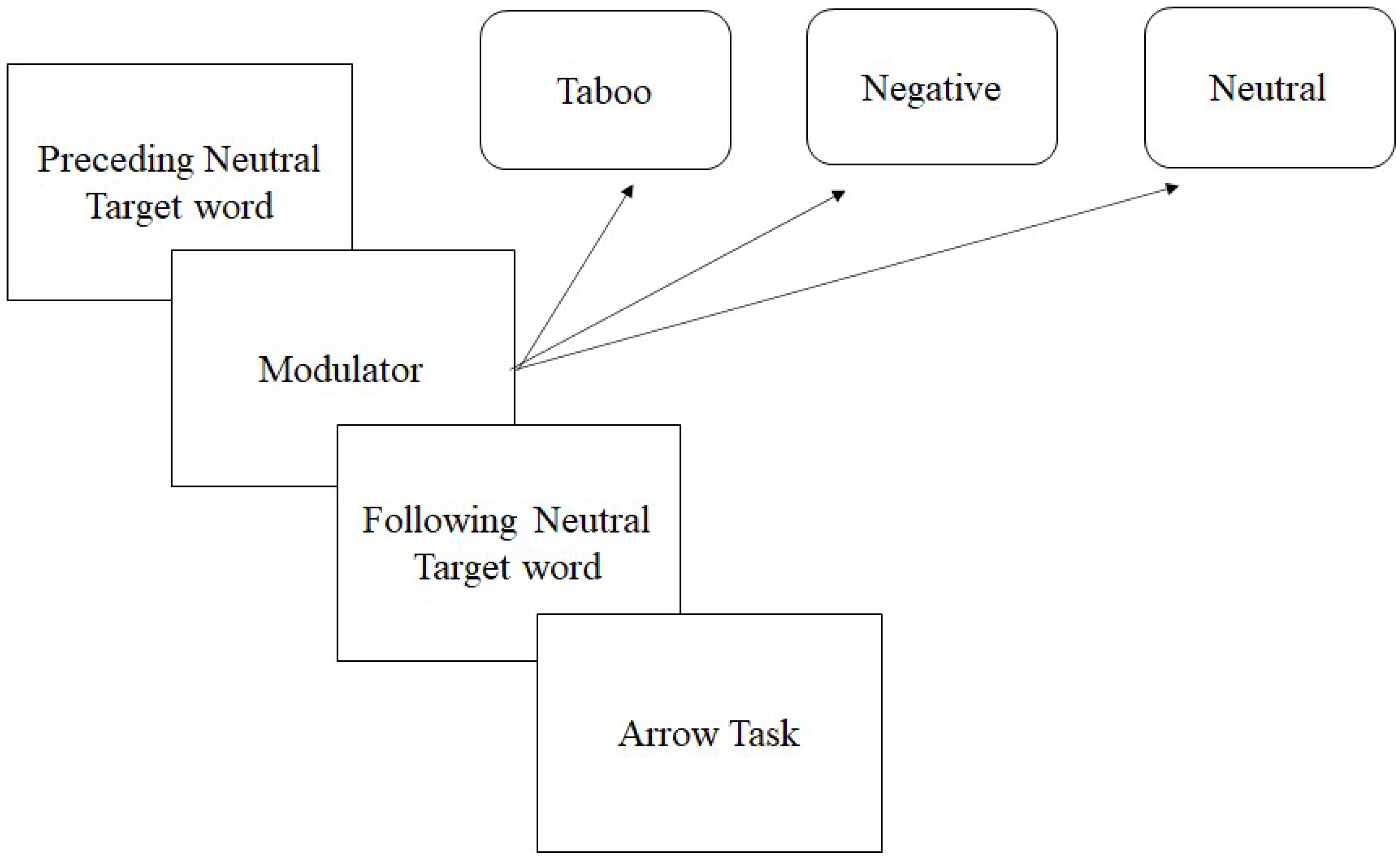
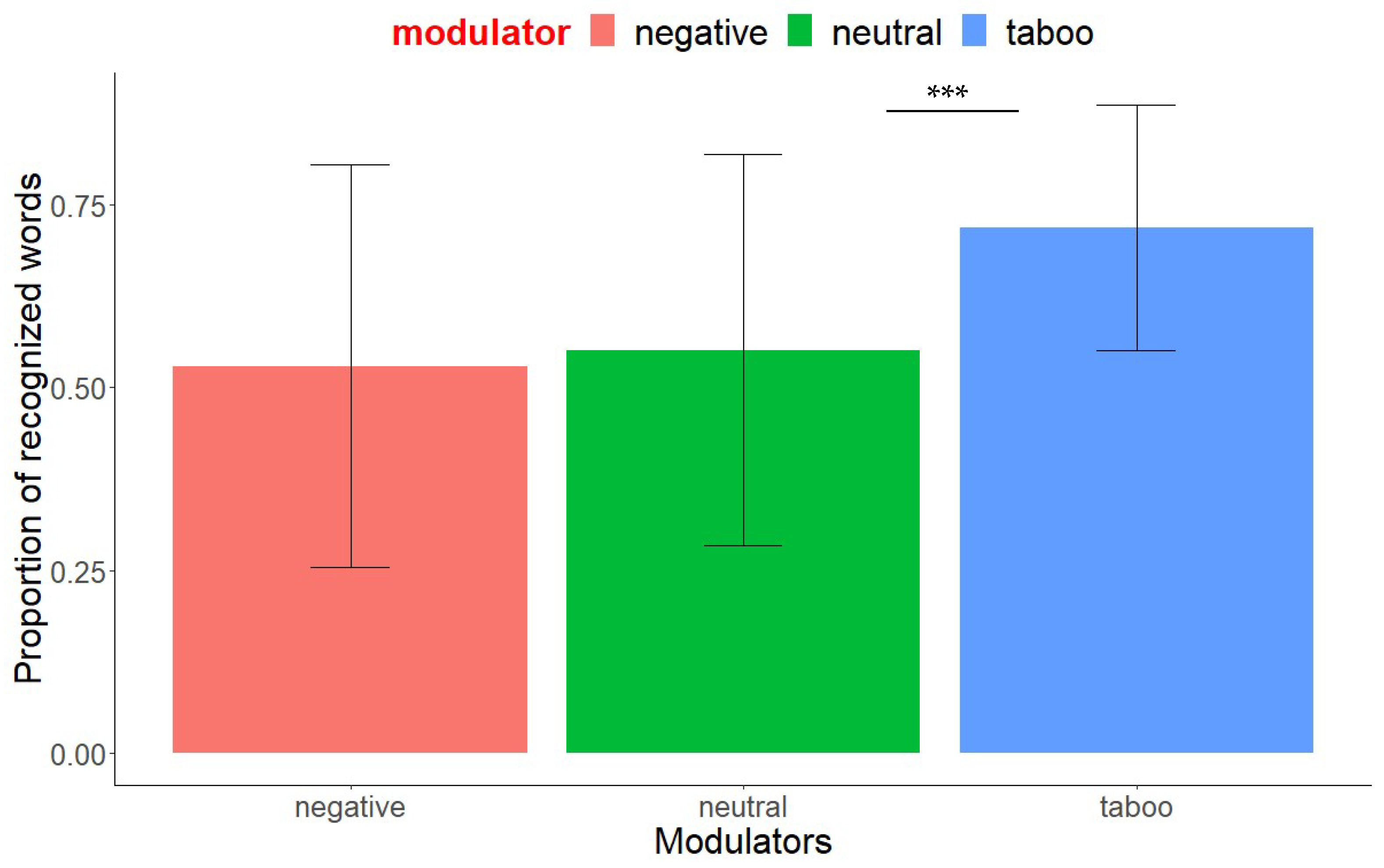
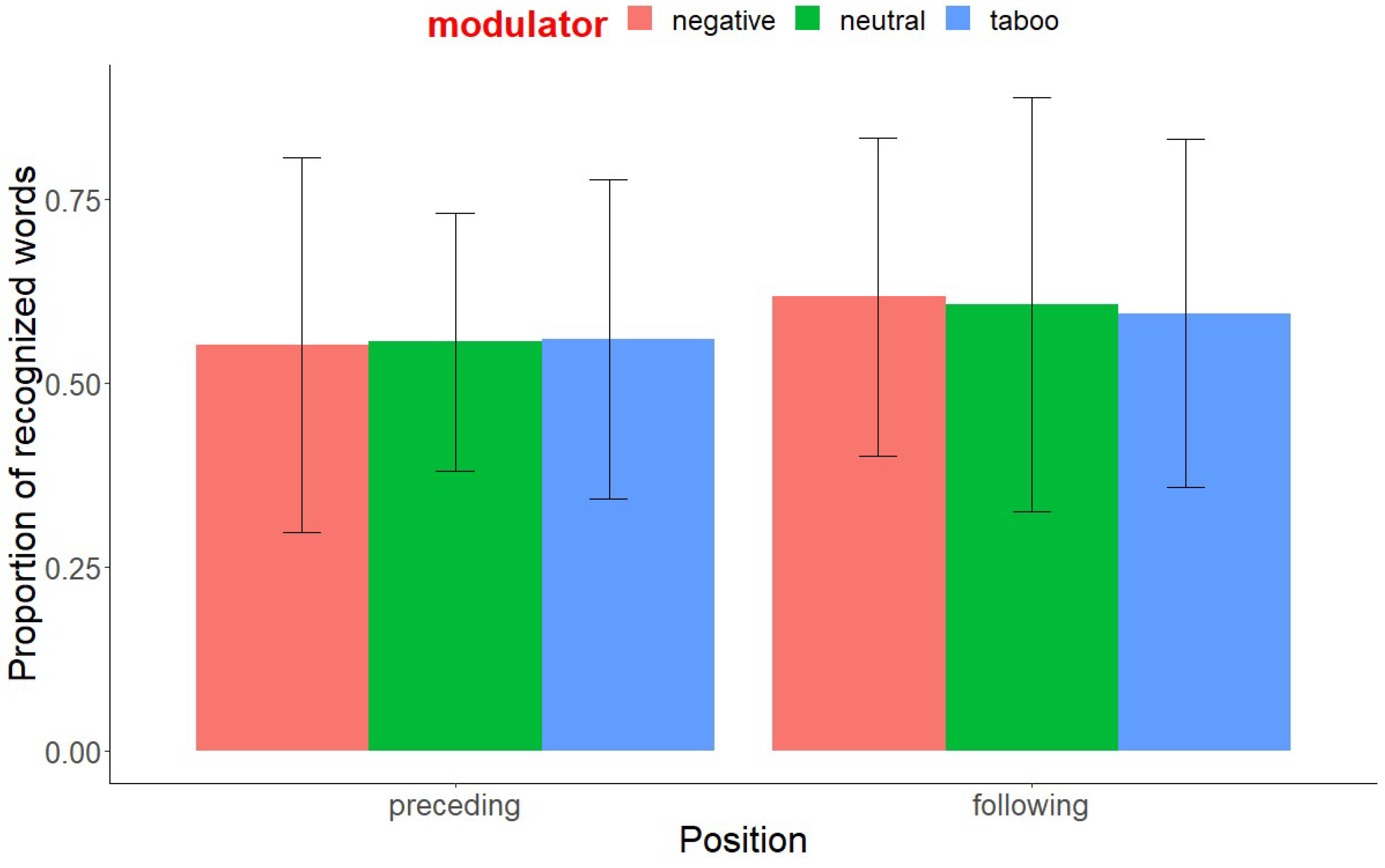
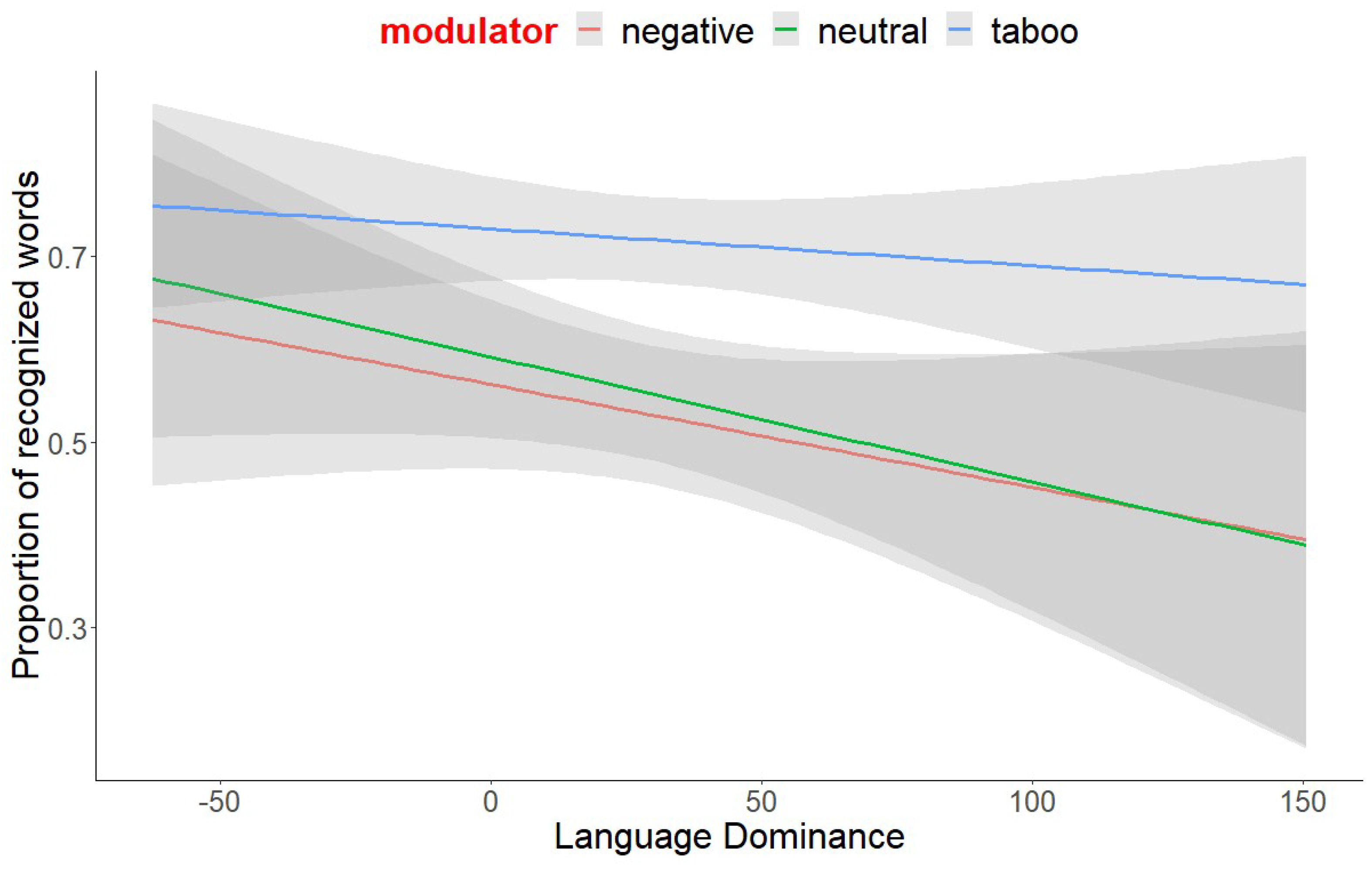
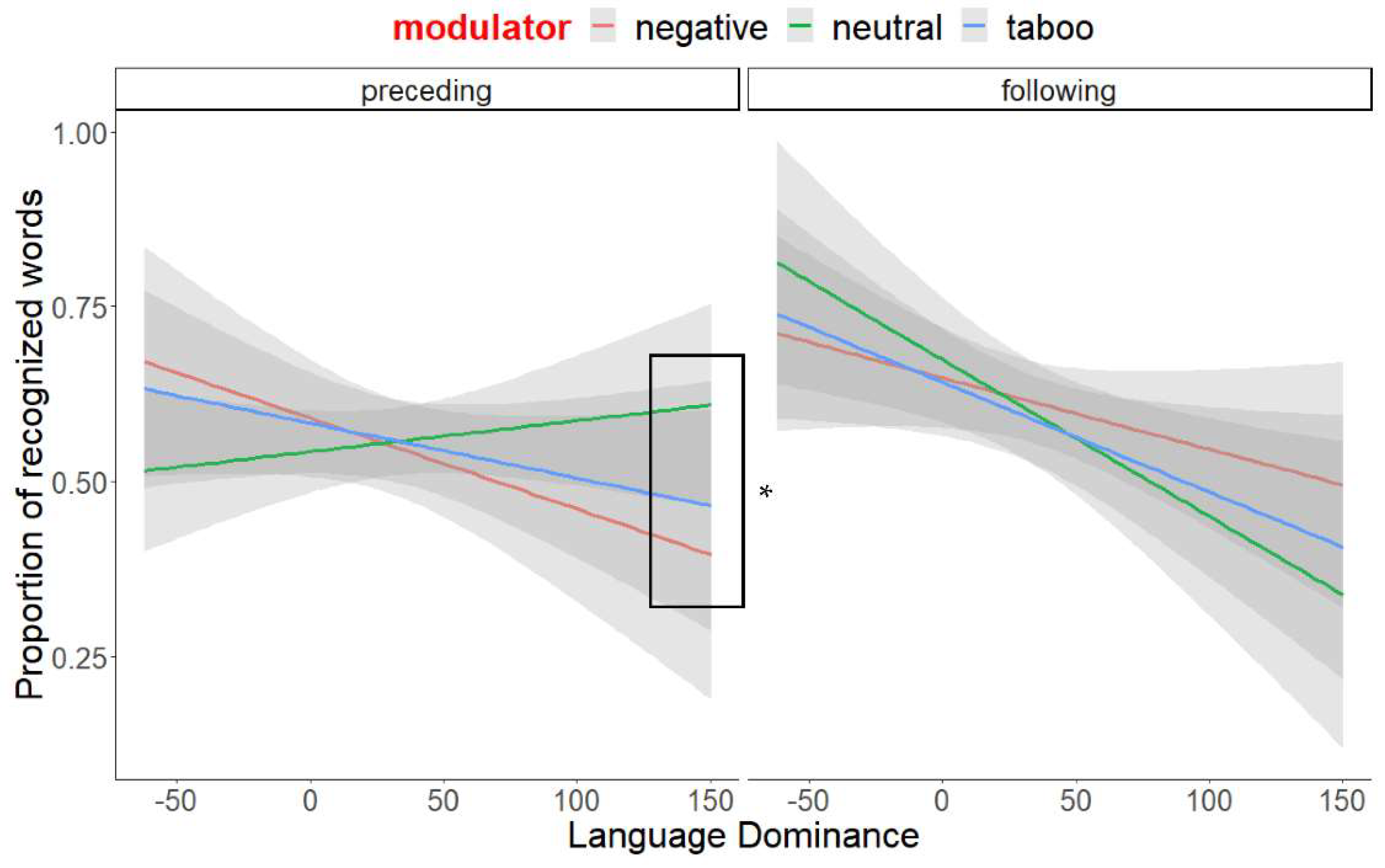
| Model | AIC | X2 | df | p |
|---|---|---|---|---|
| Age of Acquisition | −187.26 | 15.06 | 9 | 0.09 |
| Self-reported proficiency | −186.50 | 14.29 | 9 | 0.11 |
| Elicited Imitation Task | −101.80 | 15.915 | 9 | 0.07 |
| Verbal Fluency | −113.06 | 5.76 | 9 | 0.76 |
| Bilingual Language Profile | −191.21 | 18.99 | 9 | 0.03 * |
| Measure | Mean | SD | Min. | Max. |
|---|---|---|---|---|
| Bilingual Language Profile | 29.29 | 42.53 | −62.30 | 150.47 |
| Elicited Imitation Task | 122.37 | 14.41 | 141 | 86 |
| Verbal fluency | ||||
| English | 49.48 | 9.43 | 32 | 68 |
| Spanish | 38.27 | 9.20 | 18 | 59 |
| Self-reported proficiency | ||||
| Spanish | 18.7 | 4.79 | 2.0 | 24 |
| English | 22.65 | 1.68 | 24 | 18 |
| Verbal Fluency | Self-Reported Proficiency | ||||||
|---|---|---|---|---|---|---|---|
| EIT | Spanish | English | Relative | Spanish | English | Language Dominance | |
| EIT | -- | -- | -- | -- | -- | -- | -- |
| Verbal fluency | |||||||
| Spanish | 0.21 ** | -- | -- | -- | -- | -- | -- |
| English | 0.22 ** | 0.68 *** | -- | -- | -- | -- | -- |
| Relative | 0.01 | −0.38 *** | 0.43 *** | -- | -- | -- | -- |
| Self-reported proficiency | |||||||
| Spanish | −0.02 | 0.31 *** | 0.28 | −0.04 | -- | -- | -- |
| English | −0.06 | −0.08 | 0.16 ** | 0.29 *** | 0.04 | -- | -- |
| Language Dominance | −0.08 | −0.21 ** | −0.08 | 0.16 ** | −0.78 *** | 0.22 *** | -- |
Publisher’s Note: MDPI stays neutral with regard to jurisdictional claims in published maps and institutional affiliations. |
© 2022 by the authors. Licensee MDPI, Basel, Switzerland. This article is an open access article distributed under the terms and conditions of the Creative Commons Attribution (CC BY) license (https://creativecommons.org/licenses/by/4.0/).
Share and Cite
Vargas Fuentes, N.A.; Kroll, J.F.; Torres, J. What Heritage Bilinguals Tell Us about the Language of Emotion. Languages 2022, 7, 144. https://doi.org/10.3390/languages7020144
Vargas Fuentes NA, Kroll JF, Torres J. What Heritage Bilinguals Tell Us about the Language of Emotion. Languages. 2022; 7(2):144. https://doi.org/10.3390/languages7020144
Chicago/Turabian StyleVargas Fuentes, Nicole A., Judith F. Kroll, and Julio Torres. 2022. "What Heritage Bilinguals Tell Us about the Language of Emotion" Languages 7, no. 2: 144. https://doi.org/10.3390/languages7020144
APA StyleVargas Fuentes, N. A., Kroll, J. F., & Torres, J. (2022). What Heritage Bilinguals Tell Us about the Language of Emotion. Languages, 7(2), 144. https://doi.org/10.3390/languages7020144







